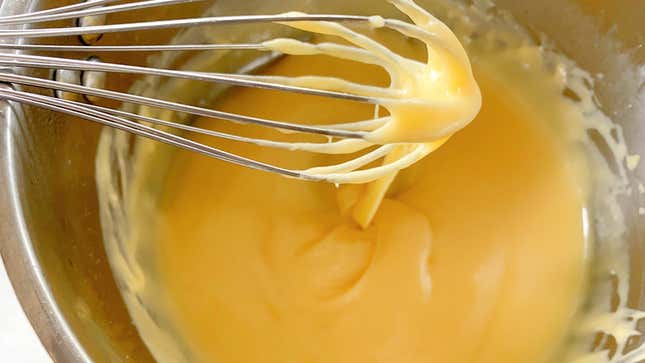I consider myself a champion of processed cheese. Velveeta, Kraft Singles, and the like may not belong on a cheese board, but they have their places, usually in a Crockpot of queso dip, in a grilled cheese sandwich, or on a burger. They are engineered to melt and stay gooey and stretchy, something you don’t get with a melted block of aged cheddar. These processed beauties owe their texture to melting salts—namely, sodium citrate.
If you’re startled by IUPAC-sounding ingredients, take a breath. There’s nothing wrong with synthetic ingredients (in fact they’re preferable in cases where purity and reproducibility matter), but you can make your very own sodium citrate—and very own “processed” cheese—in your kitchen. All you need is lemon juice and baking soda.
What is sodium citrate?
Table of Contents
Sodium citrate is a melting salt. You can buy it online, but it’s a little more fun to make your own. As I’ve explained previously, it’s the stuff that keeps processed cheese moving and grooving, and prevents it from greasing out:
If you’ve ever melted a hard cheese like cheddar, you probably noticed that it tends to separate into a gloppy, greasy mess. Sodium citrate prevents this by acting as an emulsifier, reducing the cheese’s acidity (increasing the pH) and making the proteins more soluble. This, plus the addition of a little water, lets a solid piece of cheese melt down into a creamy sauce that won’t separate or break.
You can buy sodium citrate, but—as I learned by watching this video from Adam Ragusea—you can make your own melting salt with a simple acid base reaction.
The equation for this reaction looks like this:
Citric acid (lemon juice) + Sodium bicarbonate (baking soda) → Carbon dioxide (CO2) + Sodium citrate (Salt)
You’ll know the reaction is done when it stops fizzing (those bubbles are carbon dioxide gassing off), even after agitation. Once it’s done, you’re left with sodium citrate in an aqueous solution. From there, you can add a little more liquid (water, milk, and beer all work), and your cheese of choice. The sodium citrate will reduce the pH of the cheese, letting it melt and meld into a gooey sauce. (I know you can also make a cheese sauce with a roux, but this is a neat little trick for those who are avoiding gluten, and it works wonders with sharper cheeses.)
Make sure that acid-base reaction is complete
I tried making this sauce with Adam’s method three times, with a pre-shredded mozz, a sliced havarti, and a pre-shedded “Mexican blend,” and the last one was the most successful. They all have a similar pH, but the shredded mozz came out curdled, while the havarti came out greasy, with a layer of liquid on top that just would not emulsify.
There could be a couple of reasons for this. Adam recommends using 50 milliliters of lemon juice and a 1/2 teaspoon of baking soda, but lemons are not made in labs, and the amount of acid in any given amount of lemon juice can vary. This means slightly different amounts of baking soda may be required to neutralize the acid, and the amount of sodium citrate produced can also vary.
When making the last batch of cheese sauce, I mixed the recommended amount of juice and baking soda together, stirred it around until it stopped fizzing, then repeated the process with tiny pinches of baking soda, until I was able to add a pinch with no fizzing at all. Then I knew the reaction was complete.
The other thing that helps is adding the cheese slowly, and whisking (with a wire whisk, not a spoon) between each addition to completely melt the each portion before adding more. Stop when you have a sauce, even if you haven’t added the full 200 grams of cheese. (Also, some pre-shredded cheeses are coated in starches that may interfere with the sodium citrate, but my most successful sauce was made with pre-shredded cheese, so don’t worry about it too much.)
Gooey Cheese Sauce (via Adam Ragusea)

Ingredients:
- 50 milliliters lemon juice
- 1/2 teaspoon baking soda + a few little pinches
- 80 milliliters water, milk, or beer
- 200 grams shredded cheddar cheese
Add the juice and baking to a sauce pan and stir. Keep stirring until it stops fizzing. Add a tiny pinch of baking soda and stir again. Repeat, until the mixture no longer fizzes when you add a tiny pinch of baking soda.
Add your liquid and bring the mixture to a simmer. Add the cheese, small handfuls at a time, whisking in between additions to completely melt the cheese. Repeat until all the cheese has been added and you have a gooey, creamy cheese sauce.
